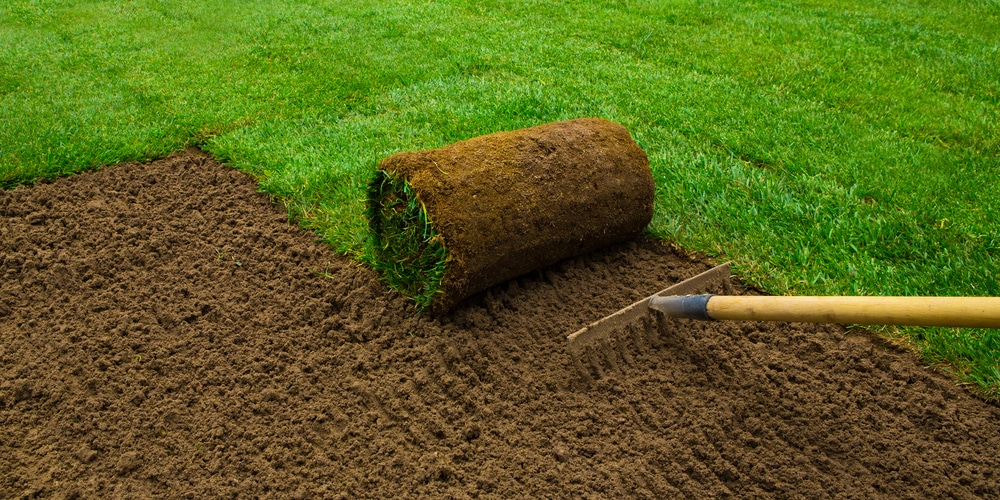When you want a new lawn installed, one of the first decisions you must make is whether to go with sod or seed. If you decide on sod, one of your next questions will be: how long does sod take to root?
Shallow Roots vs. Deep Roots

Just as a plant’s leaves and branches are necessary for photosynthesis and structure, the roots are essential for taking in water and nutrients from the soil.
The root system also anchors the plant in the ground and helps to protect it from being uprooted by strong winds. When choosing sod for your lawn, you must decide whether you want shallow or deep-rooted grass. Each type has its advantages and disadvantages.
Shallow-rooted grasses, such as Bermuda grass, are well adapted to hot, dry climates. They have a compact root system that enables them to quickly soak up water and nutrients from the top layer of soil. However, shallow roots also make plants more susceptible to drought stress and heat damage.
In contrast, deep-rooted grasses, such as fescue, have a more extensive root system that enables them to access moisture and nutrients from lower levels of the soil. This makes deep-rooted grasses more tolerant of drought conditions. However, deep roots can also make grasses more susceptible to compaction and flooding.
As you can see, there are pros and cons to both shallow-rooted and deep-rooted types of grass. Ultimately, the best type of grass for your lawn will depend on your area’s climate and soil conditions.
Sod vs. Seed: Which is Faster?
When creating a new lawn, there are two basic options: sod and seed. Both have advantages and disadvantages, but one of the biggest considerations is speed. So which is faster: sod or seed?
Sod is the faster option. It can be installed in a few hours, and you can start using your lawn immediately. Seed, on the other hand, takes longer to grow. You need to wait for the seed to germinate and then for the grass to mature. So if you’re looking for a quick solution, sod is the way to go.
However, a seed has its advantages. First of all, it’s usually cheaper than sod. And second, you have more control over the type of grass you’re growing. With seed, you can choose from a wide variety of grasses, while with sod, you’re limited to whatever type of grass is available in your area. So if you’re looking for a more affordable option or want more control over the type of grass you’re growing, a seed is the better choice.
No matter which option you choose, sod or seed, it’s important to remember that a new lawn takes time and care to establish. Be patient, and don’t expect your lawn to look perfect overnight. With a bit of time and effort, you’ll have a beautiful lawn that you can enjoy for years to come.
How Long Does Sod Take to Root?
For many homeowners, a healthy and lush lawn is the perfect way to improve curb appeal and create an inviting outdoor space. However, a premium lawn doesn’t happen overnight.
A critical factor in achieving a beautiful lawn is giving the sod enough time to take root. But how long does sod take to root?
The answer depends on several factors, including the type of sod, the time of year, and the climate. In general, most types of sod will take between two and four weeks to fully root.
However, in cooler climates or during the fall and winter months, it can take up to six weeks for the sod to establish a strong root system. You can achieve the lawn of your dreams with proper care and patience.
First Phase: Shallow Rooting
Although you may be eager to show off your new lawn, giving the roots time to establish themselves is essential. Sod is installed in a thin layer of soil, meaning the roots are relatively shallow.
The most crucial step in preventing harm is to avoid any disturbances during the root-growing phase. For at least the first month, no foot traffic or lawnmowers are permitted.
Watering is also essential during this time; the area should be watered daily to keep the roots growing. With a bit of patience, you’ll soon have a healthy and vibrant lawn that you can enjoy for years to come.
Encouraging Deep Rooting
Maintaining a healthy lawn requires more than just regular watering and mowing. According to several experts, reducing irrigation frequency after the first week is the key to developing deep roots. Instead of saturating the ground daily, water deeply but less often.
This forces roots to search for moisture, leading to full root establishment after 30 or 45 days. If you’ve planted the turf and it’s firmly established, you may begin mowing. Allow it to dry for 48 hours before cutting, and avoid cutting damp grass. Your fresh sod will flourish if given the attention it needs.
Rapid Rooting
A new lawn is a significant investment. You want to do everything you can to ensure it takes root quickly and becomes a beautiful, healthy part of your garden.
Fortunately, there are a few simple steps you can take to encourage your sod to take root. First, use a lawn roller immediately after installation. This will help the new roots and topsoil to adhere to one another. Second, fertilize six weeks after installation.
Use a slow-release fertilizer that is high in nitrogen and spread the nutrients evenly over the lawn. These two simple steps will help your new lawn to take root quickly and become a beautiful addition to your garden.
Checking If Sod Has Taken Root
Checking the root growth of your lawn is a simple process that can give you valuable information about the health of your grass. Lift a corner of your sod to check root growth and note the resistance.
If the sod comes up very quickly, there is minimal root growth. However, deep roots have been established if it is difficult to lift the sod or if there is a lot of resistance.
This simple test can give you a good indication of the overall health of your lawn and can help you determine if additional fertilization or watering is necessary.
How long does sod take to root: Conclusion
A healthy and vibrant lawn is the perfect way to improve curb appeal and create an inviting outdoor space. However, a premium lawn doesn’t happen overnight.
One important factor in achieving a beautiful lawn is giving the sod enough time to take root. But how long does sod take to root? The answer depends on several factors, including the type of sod, the time of year, and the climate. In general, most types of sod will take between two and four weeks to fully root.
However, in cooler climates or during the fall and winter months, it can take up to six weeks for the sod to establish a strong root system. You can achieve the lawn of your dreams with proper care and patience.
Related Article: Can You Put Sod Over Grass


